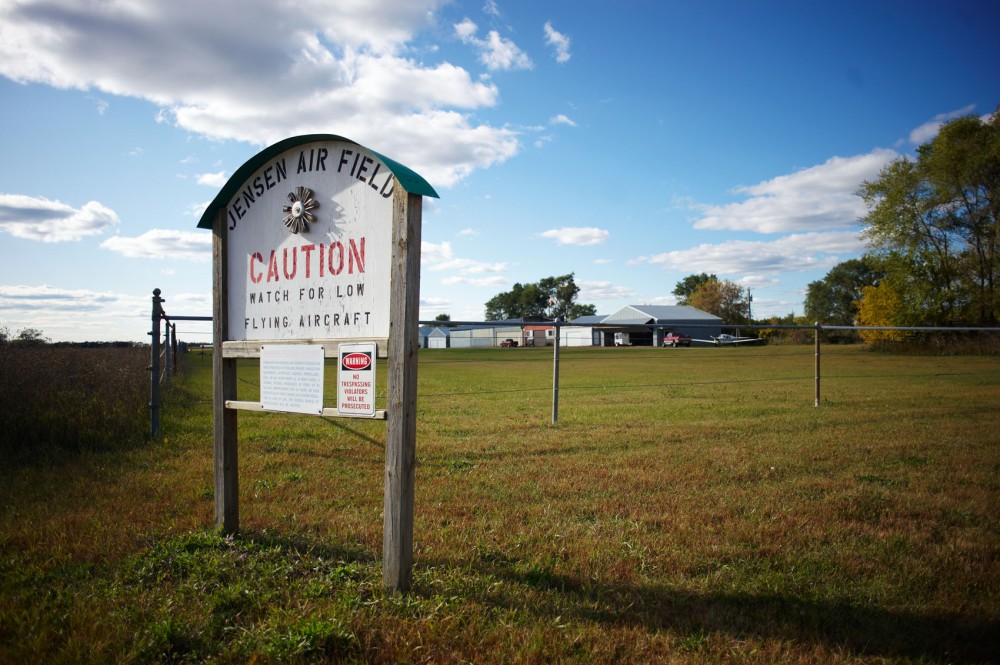Part of the University of Minnesota’s UMore Park property in Rosemount, Minn., was once home to Jensen Airfield — a grassy runway with 13 airplane hangars.
By November 2010, most of it was gone.
Ten pilots appealed their case for relocation benefits from the University at the Minnesota Court of Appeals on Wednesday.
Attorney Jon Morphew argued that, under the 1970 federal Uniform Relocation Act, assistance is required for those displaced by federally funded projects — in this case the construction of a wind turbine with federal stimulus funds.
From the University’s point of view, the lease had already expired by the time the school announced the construction project to the fliers.
More than an airport
In 1980, the Board of Regents approved the lease of eight of UMore’s 5,000 acres for an airfield. The founders, one Korean War veteran and one member of an engineering union, were looking for space to train workers to level land.
In November 1982, the pilots began their lease. Pilots paid their share of rent to Jensen Field, Inc., which in turn paid the University for use of the land.
“They were looking for kind of a grassroots airport that would be close to home,” said Delta Air Lines pilot Clay Adams, who was president of Jensen Field, Inc.
“It was an incredible airport. We called it basically the ‘field of dreams,’ ‘the grass airport,’ the grass strip where people could go out and kick back and enjoy basic flying — you didn’t have to worry about wearing your tires out on the pavement,” he said.
Like Adams’ bright yellow 1946 Piper Cub — the same plane his dad taught him to fly in — most of the planes at the field were classics, he said. But it wasn’t uncommon to see Army Blackhawks, T-6 Texans and other “warbirds” fly in and out on the grass runway — one of the longest of its kind in Minnesota.
University aerospace engineering students also used the field for training.
Jeff Parker of Bloomington paid about $1,300 per year, plus property taxes, to store his two-seat sport plane at Jensen Airfield.
“I learned to fly there,” he said. “The grass runway was beautiful. … I could take off, get up to at least 500 feet and still land on the runway.”
Development at UMore
In the mid-’90s, the University began only leasing the field on a year-to-year basis, denying the pilots’ requests to sign longer leases.
The University planned to develop the park.
In 2008, the University announced a roughly 30-year plan for UMore Park, outlining the creation of an eco-industrial park and sustainable community.
In its case brief for the relocation case, the University said Jensen Airfield flyers had known since 1998 that the future of the field was uncertain since the school had plans to eventually only lease to those with University academic affiliations.
Seventeen days after Jensen’s lease expired on Oct. 31, 2009, the University extended the Jensen lease a final time, through Oct. 31, 2010, but told the pilots it would be the last extension.
A wind turbine, to be built with the help of $8 million in federal stimulus grant funds, would make flying at the Jensen site dangerous, the University said.
Last September, in response to the pilots’ request for a hearing, Kathleen O’Brien, vice president of University Services, found Jensen Field, Inc. aviators were not displaced persons under the URA and were therefore ineligible for benefits. She also found that Jensen didn’t adequately document the claims for which they wanted reimbursement.
The flyers asked for $141,825 based on an estimate of moving expenses.
Parker estimated the cost of crating his plane, moving it to its new home in Le Sueur, Minn., tearing down his hangar, building a new one and moving his tools was $40,000.
Arguments
Having heard oral arguments Wednesday, the state Court of Appeals has 90 days to rule.
One issue central to the case is whether the field’s displacement was a “direct result” of the federally funded turbine. The turbine wasn’t built directly on the eight-acre field parcel, but its proximity would make airplane operation unsafe, the University said.
About the time the lease expired, though, an environmental impact study determined that sand and gravel mining on the Jensen Field site was feasible.
Jennifer Frisch, an associate counsel for the University, said Wednesday that since the lease had expired by the time the University notified the hobbyists, it was the end of a lease — not the federally funded project — that displaced Jensen Airfield.
“[The University] is simply acting as a landlord,” she told the three-judge panel. “The reasons for the termination of the lease do not matter because they are not displaced persons.”
Morphew argued the sole reason for displacement was the turbine.
“There was a federal grant that directly resulted in them having to move, and there was no other reason,” he said.
Adams has since moved his plane to Airlake Airport, which has a paved runway. He still misses Jensen Airfield.
“If it was a sunny night, a clear night or evening, everybody was out at the airport, whether it was [for] flying or just sitting back,” he said. “And a lot of times, it was perfect conditions where everybody was in the air flying.”








